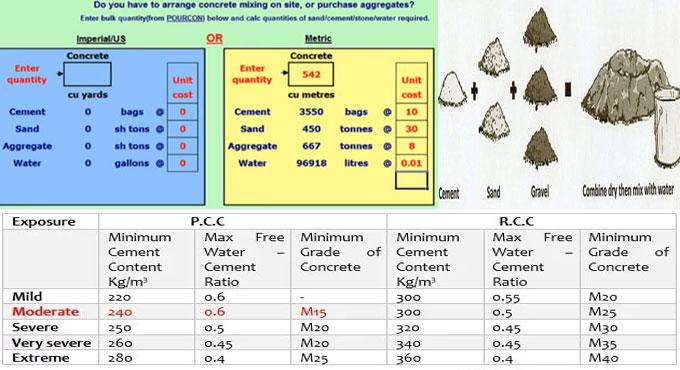
How to work out Concrete Mix Design
Concrete mix design means the method of choosing appropriate components of concrete and finding out their relevant amounts with the purpose of forming a concrete by maintaining perfect functionality, strength and longevity as inexpensively as possible.
Types of Mixes:
Standard mixes: As per IS 456-2000 standard, there are different types of grades for the concrete mixes which range from M10, M15, M20, M25, M30, M35 and M40.
The letter M stands for the Mix and the number to the stated 28 day cube compressive strength of the mix in N/mm2.
The mixes of grades M10, M15, M20 and M25 match roughly to the mix ratios (1:3:6), (1:2:4), (1:1.5:3) and (1:1:2) correspondingly. The quality of concrete is based on various factors and the standard mix just provides us a rough estimate of the quantities of material needed. So, standard mixes are utilized only for very small jobs, when the 28-day strength of concrete remain under 30 N/mm2.
Designed Mixes: Designed mixes are distinctly created to obtain the least strength specified by the Structural designer. These concrete mix are designed on the basis of various factors like the knowledge of the materials, site exposure conditions and standard of supervision attainable at the site of work.
Besides, it is essential for the site engineer to produce the concrete at site, strictly adheres to the parameters recommended by the mix designer to get the minimum strength stated by the structural engineer.
The concrete mix is designed with the objective of acquiring the specified minimum strength and stability to produce the concrete cost-effectively.
As the cost of cement surpasses the cost of other ingredients in several times, consideration should be given to use fewer amount of cement as possible in accordance with strength and longevity.
Concrete design is based on the following factors :-
Type of Concrete, Grade designation, Shape of Particle, Slump, Water-Cement Ratio, Exposure Condition, Concrete Placement, Degree of Supervision, Sieve Analysis(FA), Sieve Analysis(CA), Chemical Admixture, S.G. Fine Aggregate, S.G. Coarse Aggregate, S.G. of Cement, S.G. of Admixture, Water Absorption, Surface Moisture
Type of concrete: In accordance with IS456:2000 the following quantities are subject to the type of concrete (i.e. Plain Cement Concrete or Reinforced Cement Concrete).
Minimum Cement Content
Maximum Water-Cement Ratio
Minimum Grade of Concrete
Values for the above quantities are given in Table 5 of IS 456:2000 for diverse exposure conditions.
Grade Designation
According to IS 456:2000 Cl.6.1
The concrete should reamin in grades indicated as per Table 2 of IS 456:2000. The characteristic strength is described as the strength of material under which not over 5 per cent of the test results are anticipated to fall.
The lowest grade of concrete for plain and reinforced concrete should be in accordance with Table 5 of IS 456:2000.
Concrete having grades lower than those provided in Table 5 of IS 456:2000 should have been utilized for plain concrete constructions, lean concrete, simple foundations, foundation for masonry walls and other simple or temporary reinforced concrete construction.
Shape of particle: The quantity of highest mixing water per unit volume of concrete should be set from Table 2 of IS 10262:2009. The water content in Table 2 of IS 10262:2009 is intended for angular coarse aggregate as well as for 25 to 50 mm slump range. To maintain equivalent workability, the water estimate in Table 2 of IS 10262:2009 can be decreased by roughly.
? 10 kg for sub-angular aggregates,
? 20 kg for gravel with some crushed particles and
? 25 kg for rounded gravel.


